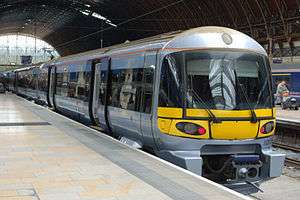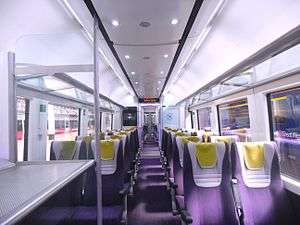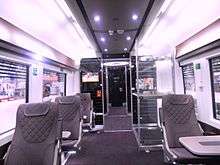British Rail Class 332
The British Rail Class 332 is a type of electric multiple unit train built by CAF and Siemens Mobility. A total of 14 units have been produced all for use on the Heathrow Express between London Paddington and Heathrow Airport.[3]
| British Rail Class 332 | |
|---|---|
 Five-car Heathrow Express EMU 332002 at Paddington | |
 The interior of refurbished Standard Class accommodation aboard a Class 332 | |
| In service | 23 June 1998 - 29 February 2016[1] 12 March 2016 - present[2] |
| Manufacturer | CAF and Siemens Mobility |
| Built at | Zaragoza, Spain |
| Refurbished | 2012-2013 |
| Number built | 14 trainsets |
| Formation | 4-5 cars per set |
| Capacity | 175 seats (4 cars) 239 seats (5 cars) |
| Operator(s) | Heathrow Express |
| Specifications | |
| Car length | Driver cab (excluding couplers) at two ends: 22.95 m (75 ft 4 in) Other cars (excluding couplers): 22.9 m (75 ft 2 in) |
| Width | 2.733 m (8 ft 11.6 in) |
| Height | 3.774 m (12 ft 4.6 in) (excluding pantograph) |
| Maximum speed | 100 mph (161 km/h) |
| Weight | 188.4 t (185.4 long tons; 207.7 short tons) (4 cars) 233.6 t (229.9 long tons; 257.5 short tons) (5 cars) |
| Power output | 1.4 MW (1,900 hp) |
| Electric system(s) | 25 kV 50 Hz AC Overhead |
| Braking system(s) | Regenerative and air brake |
| Safety system(s) | AWS, ATP |
| Track gauge | 1,435 mm (4 ft 8 1⁄2 in) standard gauge |
Description
The fleet was built in 1997-1998 in Zaragoza having originally been designated as a Class 331.[4] The units have Automatic Train Protection (ATP) equipment, one of the few fleets in the UK to do so. This is largely as a consequence of the Paddington-Heathrow route being mainly on the Great Western Main Line, which was equipped with ATP in the early 1990s as part of a trial of the system by British Rail.[5] The units are not fitted with Train Protection & Warning System (TPWS). A derogation was issued in 2001, which exempted the class from mandatory TPWS installation.[5]
The units were the first electric trains to operate over the Great Western Main Line out of Paddington when the line was electrified as far as Airport Junction.
The Class 332 was originally constructed as three-car sets and were for the initial Fast Train service which started in January 1998. Fast Train ran between Paddington and the temporary single platform siding station called Heathrow Junction, which was constructed on the down side of the Down Airport line just before the tunnel portal.
The service frequency is four trains per hour, one every 15 minutes. The units can work on their own or in pairs, although 2 five-car units cannot be used together making the maximum length nine carriages.[6]
The units have first class and Standard class accommodation: the four-car sets can accommodate up to 175 standard class passengers, with up to 239 in the five-car sets. First class accommodation is in one of the driving cars, referred to as 'DMF' (Driving-Motor-First) cars. The first class cars have two different layouts: 332002, 332004 and the five-car sets can accommodate up to 26 first class passengers, while in the other four-car sets up to 14 first class passengers can be accommodated due to the checked luggage compartments installed in some DMF cars in 1999.[3]
One driving car in each set is usually in all-over advertising livery. This has included Tata Communications, Vodafone and Royal Bank of Scotland (RBS).[7]
The units are capable of working in multiple only with each other, and theoretically with the related Class 333 units operated by Northern, based on the same design.[8]
The units are maintained at the purpose-built train care depot at Old Oak Common.[3]
Interior Layout

.jpg)
The standard class saloons consist of 2+2 seating, arranged in airline-style layout. The majority of seats face the luggage stacks. The seats are finished in three textile colours. The first class saloons in the DMF vehicles consist of 1+1 seating, mostly in facing layout around tables. All saloons have large luggage stacks adjacent to the vestibules. Video screens display news and information. All carriages are air-conditioned and carpeted.
Although the vehicle were designed before the introduction of the Rail Vehicle Accessibility Regulations, various features were incorporated into the interior of the Standard class TSO vehicles in consultation with DPTAC (Disabled Persons Transport Advisory Committee), including a wheelchair space with communication device and a wheelchair-accessible toilet.
At the Design Business Association's Design Effectiveness Awards in 2000, a team of Design Triangle, Wolff Olins and Glazer won the Grand Prix and Design Management awards for the design of the units.[9]
In 1999, seven DMF first class vehicles were converted to include checked luggage compartments, with a partition in the centre of the car. The compartments were taken out of service when the checked luggage service was withdrawn some years ago.
2016 recall
On 29 February 2016, the entire class was recalled by Siemens "as a safety precaution" and was taken out of service.[1] A structural defect was found on some of the trains and they were replaced in service by Class 360s operated by Heathrow Connect.[10] The Class 332 trains were gradually returned to service from 11 March 2016 onwards.[11]
Replacement
From 2020, Great Western Railway will providing a fleet of twelve Class 387 from the Bombardier Electrostar family to replace all of the 332s used on the Heathrow Express, while Heathrow Airport Holdings will continue to own Heathrow Express.[12][13] The future on the whole of the 332 fleet is unclear.
Fleet details
| Class | Operator | Number of Trains | Built | Cars per Set | Unit nos. |
|---|---|---|---|---|---|
| Class 332 | Heathrow Express | 9 | 1997–1998 | 4 | 332001–332004 332010–332014 |
| 5 | 5 | 332005–332009 |
See also
- British Rail Class 333 - similar units used by Northern in Yorkshire.
References
- "Heathrow Express fleet recalled". Global Rail News. Rail Media. 29 February 2016.
- "Heathrow Express gets back on track". Rail News. 12 March 2016.
- Class 332 & 360/2 - Heathrow Express - Siemens Mobility. Retrieved 25 February 2012.
- The All-time Guide to EMU Classifications (PDF), Modern Locomotivs Illustrated, 2011, p. 2, retrieved 19 February 2014
- Certificate of Derogation from a Railway Group Standard 01/109/DGN re-issued 25/02/2008 Archived 27 October 2014 at the Wayback Machine - RSSB. Retrieved 27 October 2014
- "Heathrow Express". CAF. Archived from the original on 28 September 2011. Retrieved 25 February 2012.
- ‘Union Jack’ wrapped Heathrow Express fleet ready to roll Archived 20 March 2012 at the Wayback Machine - Rail News from rail.co. Retrieved 25 February 2012.
- Class 333 - Northern Rail - Siemens Mobility. Retrieved 25 February 2012.
- "Joint honours at DBA Awards - Design Week". 27 October 2000.
- "UPDATE: Heathrow Express fleet out of service for "foreseeable future"". Global Rail News. Rail Media. 2 March 2016.
- "Heathrow Express and Heathrow Connect fleet update". Heathrow Express. 11 March 2016. Retrieved 17 March 2016.
- "Heathrow Express service confirmed to at least 2028". www.heathrowexpress.com. Retrieved 10 March 2020.
- http://www.railwaygazette.com/news/single-view/view/gwr-to-manage-heathrow-express-service.html
Further reading
| Wikimedia Commons has media related to British Rail Class 332. |